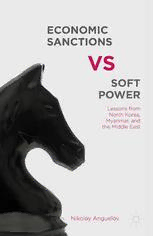
Economic Sanctions vs. Soft Power: Lessons from North Korea, Myanmar, and the Middle East PDF
Preview Economic Sanctions vs. Soft Power: Lessons from North Korea, Myanmar, and the Middle East
Economic Sanctions vs. Soft Power This page intentionally left blank Economic Sanctions vs. Soft Power Lessons From North Korea, Myanmar, and the Middle East NIKOLAY ANGUELOV Palgrave macmillan ECONOMIC SANCTIONS VS. SOFT POWER Copyright © Nikolay Anguelov, 2015. Softcover reprint of the hardcover 1st edition 2015 978-1-137-52375-4 All rights reserved. First published in 2015 by PALGRAVE MACMILLAN® in the United States— a division of St. Martin’s Press LLC, 175 Fifth Avenue, New York, NY 10010. Where this book is distributed in the UK, Europe and the rest of the world, this is by Palgrave Macmillan, a division of Macmillan Publishers Limited, registered in England, company number 785998, of Houndmills, Basingstoke, Hampshire RG21 6XS. P algrave Macmillan is the global academic imprint of the above companies and has companies and representatives throughout the world. Palgrave® and Macmillan® are registered trademarks in the United States, the United Kingdom, Europe and other countries. ISBN 978-1-349-70655-6 ISBN 978-1-137-52376-1 (eBook) DOI 10.1057/9781137523761 Library of Congress Cataloging-in-Publication Data Anguelov, Nikolay. Economic sanctions vs. soft power : lessons from North Korea, Myanmar, and the Middle East / by Nikolay Anguelov. pages cm Includes bibliographical references and index. 1. Economic sanctions—Burma. 2. Economic sanctions— Korea (North) 3. Economic sanctions—Middle East. 4. International trade. 5. Investments, Foreign. I. Title. HF1586.7.A54 2015 327.1(cid:2)17—dc23 2015002003 A catalogue record of the book is available from the British Library. D esign by Newgen Knowledge Works (P) Ltd., Chennai, India. First edition: July 2015 10 9 8 7 6 5 4 3 2 1 Contents List of Figures and Tables vii Acknowledgments ix Introduction 1 1 Economic Sanctions: An Overview 3 2 Myanmar—20 Years of Sanctions and Their Lasting Effect 21 Nikolay Anguelov and Kristin Bryant 3 Myanmar’s Sanction Legacy: The Results of Nonengagement 33 Nikolay Anguelov and Kristin Bryant 4 Absorb and Control: How North Korea Responds to Economic Sanctions 59 Bradley J. Hornback and Nikolay Anguelov 5 Alternatives to Sanctions 71 Tiffany Kaschel and Nikolay Anguelov 6 Sanctions or Soft Power: Implications for Competitiveness 111 7 Engage or Not? Conclusions and Policy Implications 133 Notes 151 References 161 Index 189 This page intentionally left blank Figures and Tables Figures 3.1 GDP, 1987–2007. Change in the value of GDP over time 35 3.2 Total and US net exports, 1987–2007 36 3.3 Major trading partners, 1987–1997 38 3.4 Major trading partners, 1998–2008 39 3 .5 Change in value added to GDP by industry, 1987–2007 5 2 4 .1 Value added to GDP byc onstruction spending 6 6 4.2 DPRK imports and exports 67 Tables 2.1 OLS regression, OER GDP, 1987–2007 30 2.2 OLS regression, OER GDP, 1987–2007, controlling for time effect 31 3.1 Myanmar FDI net inflows in the three sanction periods 40 3.2 Myanmar total official net financial flows 41 3.3 Value added to GDP by agriculture, hunting, forestry, and fishing 44 3.4 Value added to GDP by wholesale, retail trade, restaurants, and hotels 45 3.5 Value added to GDP by mining, manufacturing, and utilities 46 3.6 Value added to GDP by transport, storage, and communication 47 3.7 Value added to GDP by construction 48 3.8 Value added to GDP by other activities 50 5.1 Fixed effects cross-sectional time series regression analysis, government effectiveness 98 viii Figures and Tables 5.2 Fixed effects cross-sectional time series regression analysis, political stability 104 5.3 Cross-sectional time series regression analysis, FDI assets 105 5.4 Cross-sectional time series regression analysis, female to male ratio, secondary school enrollment 108 Acknowledgments This book’s journey started in 2009 when two graduate students—Kristin Bryant and Bradley J. Hornback—invited me to be part of their capstone committees. They brought their passion for the subject of sanctions and their compassion for the people of Myanmar and North Korea into the research process. I am especially grateful for their unique perspectives, based on their personal experiences in South East Asia, that allowed us to discuss the rapidly changing economic dynamics of the region. During that time, the guidance of Dr. Holley Ulbrich for including the concept of rent seeking into the evaluation of sanction effectiveness was essential. We are grateful for her continued support. The idea for developing the book must be credited to Brian O’Conner who spotted the potential of conference papers to be combined into an interdisciplinary volume on sanction mitigation. His continued support for the project was essential as the collaborations grew with the very impor- tant contribution of another graduate student—Tiffany Kaschel. I am also grateful to Joshua Botvin and Trevor Mattos for their editorial contribu- tions. This book has been a truly collaborative project that has allowed me to encourage the passions of students for research, learning, and their quest to build knowledge applicable in policy dynamics.
